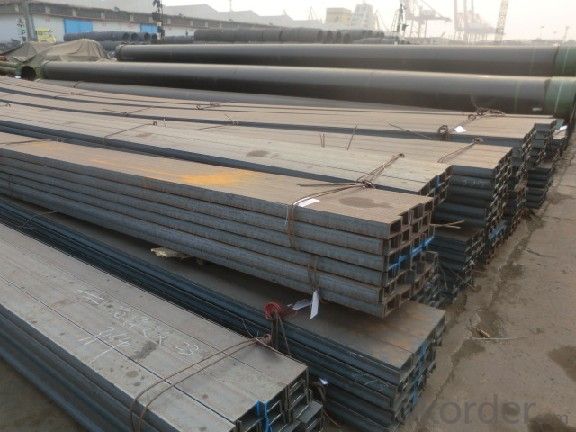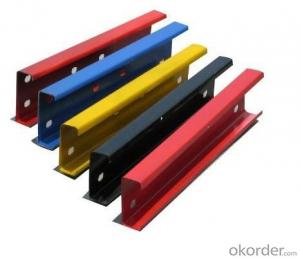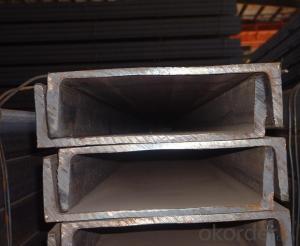U-channel JIS Standard with Different Sizes
- Loading Port:
- Tianjin
- Payment Terms:
- TT or LC
- Min Order Qty:
- 25 m.t.
- Supply Capability:
- 1000 m.t./month
OKorder Service Pledge
OKorder Financial Service
You Might Also Like
Product Description:
OKorder is offering U-channel at great prices with worldwide shipping. Our supplier is a world-class manufacturer of steel, with our products utilized the world over. OKorder annually supplies products to European, North American and Asian markets. We provide quotations within 24 hours of receiving an inquiry and guarantee competitive prices.
Product Applications:
1.The JIS channel can be devided into two kinds, namely common channel steel and light channel steel. The sizes of hot rolled common channel steel range from 5# to 40#. Meanwhile, the channel steel can be divided into cold forming sectional equal channel steel, cold forming sectional unequal channel steel, cold forming inner edge channel steel and outer edge channel steel.
2.The JIS channel is usually used for arch-itechtural structure, and they could be welded in order to support or hang a vari-ety of facilities. They are also usually used in combination with I beam. The channel steel with sizes under 14# is usually applied to construction engineering, as purline, while the channel steel with sizes above 16# is more likely to be used in building vehicle chassis structure and mechanical structure. Furthermore, the channel steel in sizes above 30# are target at building bridge structure, as tension bar.
Product Advantages:
OKorder's U-channel are durable, strong, and resist corrosion.
Main Product Features:
· Premium quality
· Prompt delivery & seaworthy packing (30 days after receiving deposit)
· Corrosion resistance
· Can be recycled and reused
· Mill test certification
· Professional Service
· Competitive pricing
Product Specifications:
1. We are definitely speciallizing in manufacturing and supplying channel steel as per japanese standard, which is characterised with high mechanical strength and competitive prices.
2. The sections in details are as followings in the table-1
JIS CHANNEL | Standard h | Sectional b | Dimension s | t | Mass: Kg/m |
(mm) | (mm) | (mm) | (mm) | ||
50x25 | 50 | 25 | 3.0 | 6.00 | 2.37 |
75X40 | 75 | 40 | 3.8 | 7.00 | 5.30 |
75X40 | 75 | 40 | 4.0 | 7.00 | 5.60 |
75X40 | 75 | 40 | 4.5 | 7.00 | 5.85 |
75X40 | 75 | 40 | 5.0 | 7.00 | 6.92 |
100X50 | 100 | 50 | 3.8 | 6.00 | 7.30 |
100X50 | 100 | 50 | 4.2 | 6.00 | 8.03 |
100X50 | 100 | 50 | 4.5 | 7.50 | 8.97 |
100X50 | 100 | 50 | 5.0 | 7.50 | 9.36 |
125X65 | 125 | 65 | 5.2 | 6.80 | 11.66 |
125X65 | 125 | 65 | 5.3 | 6.80 | 12.17 |
125X65 | 125 | 65 | 5.5 | 8.00 | 12.91 |
125X65 | 125 | 65 | 6.0 | 8.00 | 13.40 |
150x75 | 150 | 75 | 5.5 | 7.30 | 14.66 |
150x75 | 150 | 75 | 5.7 | 10.00 | 16.71 |
150x75 | 150 | 75 | 6.0 | 10.00 | 17.90 |
150x75 | 150 | 75 | 6.5 | 10.00 | 18.60 |
150x75 | 150 | 75 | 6.5 | 10.00 | 24.00 |
200X80 | 200 | 80 | 7.5 | 11.00 | 24.60 |
Packaging & Delivery of U-channel:
Packaging Detail: products are packed in coil, each coil weight around 2 MT, and then shipped by container or bulk vessel
Delivery Detail: within 45 days after received deposit or LC.
Label: to be specified by customer, generally, each bundle has 1-2 labels
Trade terms: FOB, CFR, CIF
FAQ:
Q1: How soon can we receive the product after purchase?
A1: Within three days of placing an order, we will begin production. The specific shipping date is dependent upon international and government factors, but is typically 7 to 10 workdays.
Q2: What makes stainless steel stainless?
A2: Stainless steel must contain at least 10.5 % chromium. It is this element that reacts with the oxygen in the air to form a complex chrome-oxide surface layer that is invisible but strong enough to prevent further oxygen from "staining" (rusting) the surface. Higher levels of chromium and the addition of other alloying elements such as nickel and molybdenum enhance this surface layer and improve the corrosion resistance of the stainless material.
Q3: Can stainless steel rust?
A3: Stainless does not "rust" as you think of regular steel rusting with a red oxide on the surface that flakes off. If you see red rust it is probably due to some iron particles that have contaminated the surface of the stainless steel and it is these iron particles that are rusting. Look at the source of the rusting and see if you can remove it from the surface.
Images:


- Q: Can steel channels be used in conjunction with other building materials?
- Yes, steel channels can definitely be used in conjunction with other building materials. Steel channels are versatile structural components that are commonly used in construction projects. They can be used in combination with various building materials such as concrete, wood, and bricks. When used with concrete, steel channels are often embedded or attached to provide additional strength and reinforcement. This combination is commonly used in the construction of bridges, high-rise buildings, and other structures that require enhanced load-bearing capacity. Steel channels can also be used with wood to create hybrid structures. This combination is often seen in the construction of roof trusses and floor joists, where steel channels are integrated with wooden beams to provide a stronger and more durable framework. In addition, steel channels can be used with bricks to create sturdy and stable structures. They can be embedded within brick walls to reinforce the overall structure, especially in areas that are prone to earthquakes or high wind loads. Overall, the use of steel channels in conjunction with other building materials allows for greater flexibility and strength in construction projects. The combination of different materials can help optimize the structural integrity and performance of buildings, ensuring their durability and safety.
- Q: The parameters of the channel steel of Q235B
- The execution standard is GBT706-2008 angle groove
- Q: What are the different methods for protecting steel channels from chemical exposure?
- There are several methods for protecting steel channels from chemical exposure. Some common approaches include applying protective coatings such as epoxy or polyurethane, using corrosion inhibitors, employing sacrificial anodes or cathodic protection systems, and utilizing stainless steel or other corrosion-resistant alloys. Additionally, proper ventilation and regular maintenance can also help to prevent or mitigate chemical damage to steel channels.
- Q: Can steel channels be used in the construction of mezzanine floors?
- Yes, steel channels can be used in the construction of mezzanine floors. Steel channels are commonly used in construction for their strength and durability. Mezzanine floors are typically added to existing buildings to create additional space and are often used in industrial and commercial settings. Steel channels provide structural support and can be used as beams or joists in mezzanine floor construction. They are able to withstand heavy loads and provide a stable and secure platform for various purposes, such as storage, offices, or additional workspace. Additionally, steel channels can be customized to meet specific design and structural requirements, making them a versatile choice for mezzanine floor construction.
- Q: I encountered in the construction of 2 short 28# channel welding, processed into beams, how to weld? Do I have to have stiffened panels? How many pieces? What's the thickness of the stiffener? I heard that there is a book called "metal processing manual", which has instructions, but I do not have the book. Please give settlement.
- If the gap between the two weldment is not conducive to welding, it can be welded with a piece of steel plate. If the assembly gap is reasonable, direct rust removal and welding can be done.
- Q: What are the guidelines for steel channel installation in corrosive environments?
- To ensure the longevity and effectiveness of steel channels in corrosive environments, it is crucial to adhere to several essential guidelines: 1. Material selection: Opt for a steel material specifically engineered to withstand corrosive environments. Stainless steel is often an ideal choice due to its high corrosion resistance. Additionally, carefully consider the grade of stainless steel that best suits the specific corrosive substances present in the environment. 2. Surface preparation: Thoroughly prepare the surface of the steel channels before installation. This entails removing any existing rust or corrosion, meticulously cleaning the surface, and applying a protective coating or treatment to enhance corrosion resistance. 3. Protective coatings: Apply appropriate protective coatings to the steel channels to prevent corrosion. This may involve using paints, epoxy coatings, or galvanizing. Ensure that the chosen coating is compatible with the corrosive environment and offers long-term protection. 4. Proper drainage: Design the installation in a manner that facilitates proper drainage of any corrosive substances that may come into contact with the steel channels. This helps minimize the accumulation of corrosive agents and reduces the risk of corrosion. 5. Avoid contact with dissimilar metals: Steer clear of direct contact between the steel channels and dissimilar metals, as this can trigger galvanic corrosion. If contact cannot be avoided, employ suitable insulating materials or coatings to separate the metals and prevent galvanic corrosion. 6. Regular maintenance: Conduct regular inspections and maintenance on the steel channels to identify any signs of corrosion or damage. Promptly address any issues to prevent further deterioration and ensure the continued effectiveness of the installation. 7. Follow industry standards and recommendations: Familiarize yourself with pertinent industry standards, guidelines, and recommendations for installing steel channels in corrosive environments. These resources provide valuable insights into best practices and ensure compliance with safety and performance requirements. It is crucial to seek guidance from corrosion control specialists or engineers who specialize in this field. Their expertise will ensure that the guidelines are tailored to the specific corrosive environment and intended application of the steel channels.
- Q: Can steel channels be used for mezzanine office spaces?
- Yes, steel channels can be used for mezzanine office spaces. Steel channels are commonly used in construction for their strength, durability, and versatility. They can be easily fabricated and installed to create a mezzanine structure that can support the weight of office spaces. Steel channels provide a stable and reliable base for the flooring, walls, and ceilings of mezzanine office spaces. Additionally, steel channels can be designed to meet specific load requirements, ensuring the safety of the structure. Therefore, steel channels are an excellent choice for creating mezzanine office spaces.
- Q: How do steel channels contribute to daylighting in buildings?
- Steel channels can contribute to daylighting in buildings by being used as structural components for large windows or skylights. These channels provide the necessary support and framing for these daylighting features, allowing more natural light to enter the building and reducing the need for artificial lighting.
- Q: How do steel channels contribute to the overall durability of a railway bridge?
- The durability of a railway bridge is improved by steel channels in various ways. Firstly, they offer structural support and strength, enabling the bridge to withstand heavy loads and forces. These channels are designed to evenly distribute the weight of the train across the bridge, preventing localized stress points that could cause structural failure. Furthermore, steel channels are highly resistant to corrosion and rust, which is essential for a railway bridge exposed to different weather conditions and environmental factors. This resistance to corrosion ensures the bridge remains strong and durable over time, reducing the need for frequent maintenance and repairs. Another contribution to durability is the ability of steel channels to absorb and dissipate energy. If there is a sudden impact or excessive vibrations from passing trains, the steel channels can absorb and disperse the energy, minimizing the risk of damage or structural failure. Moreover, steel channels are frequently used in constructing railway bridges due to their fire-resistant properties. Steel has a high melting point, making it less likely to deform or collapse in the event of a fire. This enhances the overall safety and durability of the bridge since it can withstand extreme temperatures for an extended period. In conclusion, steel channels are crucial for enhancing the durability of a railway bridge. They provide structural strength, corrosion resistance, energy absorption, and fire-resistant properties. Their contribution ensures the bridge's longevity and safety, allowing it to effectively support the transportation of trains and passengers for many years.
- Q: What's the name of channel steel?
- Channel only classification, no alias.Such as: waist height is the same, leg width and waist thickness of different, you can have a, B, C three models.
Send your message to us
U-channel JIS Standard with Different Sizes
- Loading Port:
- Tianjin
- Payment Terms:
- TT or LC
- Min Order Qty:
- 25 m.t.
- Supply Capability:
- 1000 m.t./month
OKorder Service Pledge
OKorder Financial Service
Similar products
Hot products
Hot Searches
Related keywords




























